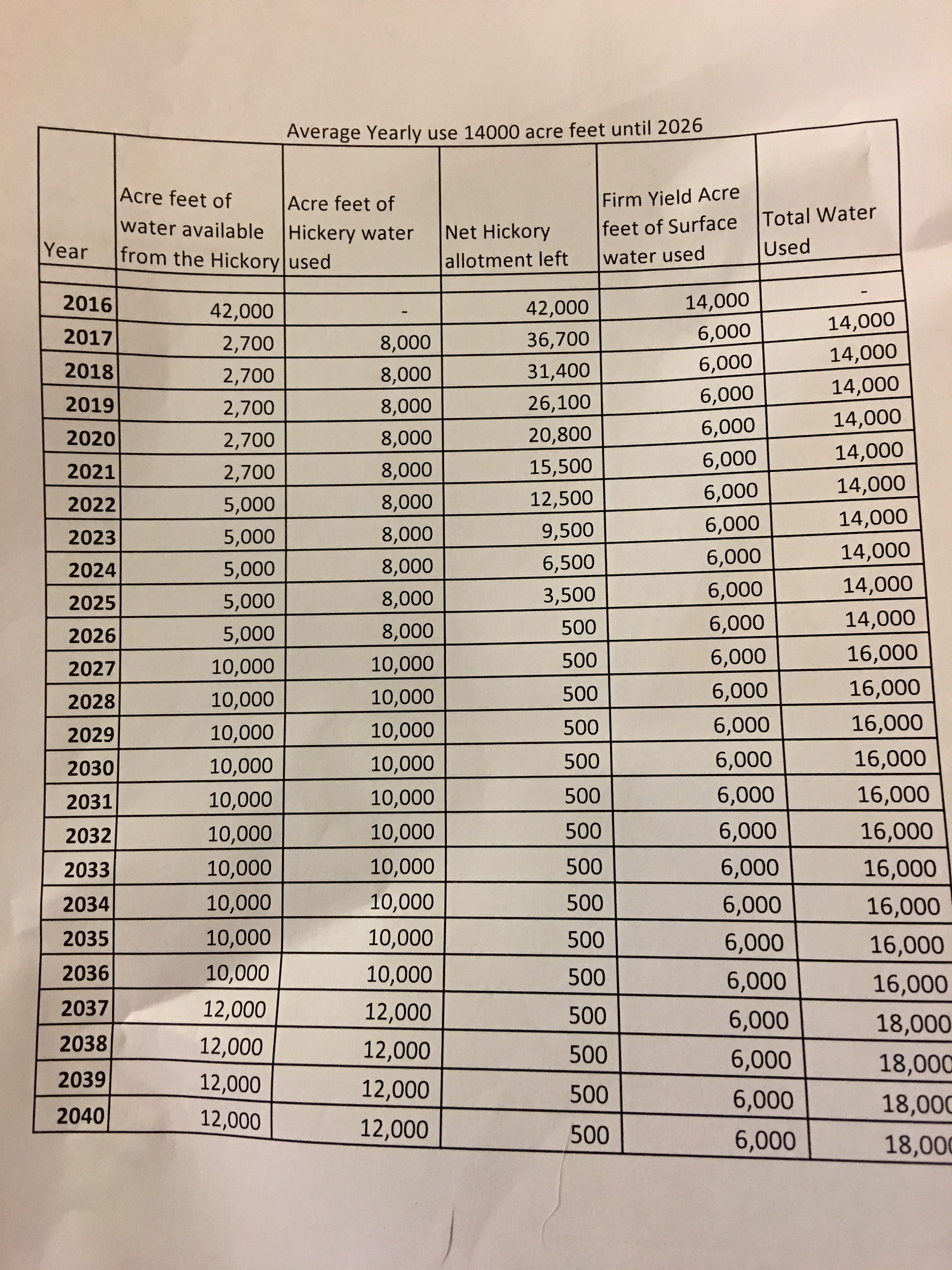Since the attention on the Water Reclamation and Reuse Program, also deemed “potty water,” came into the limelight, San Angeloans learned that city leaders can pass the initiative through without their consent. This has raised many concerns for local citizens and some city officials because not enough information is available on the program. Not to mention, the price tag associated with it. Previously, citizens were told that price tag was $136 million, but at last week’s City Council Meeting, that price tag changed to $150 million.
With these changes, citizens are asking: Is this project necessary? Can the City afford it? Is it Safe?
Last week, City Council members voted unanimously, minus Johnny Silvas, SMD 3, to a resolution for the submission of the application on this project amidst concerns.
Proponents of the plan believe water reclamation is the only reliable short- and long-term solution. The proposed design parameters would recycle 88 percent of all wastewater.
However, opponents feel this plan is unnecessary. With the Hickory Aquifer, San Angelo has about six years’ worth of water. Also, where City leaders argue current drought levels may change that, local farmers argue such has always been the case in San Angelo, and rain will come.
Thus far, San Angelo has not had to use the banked water from the Hickory because San Angelo still has surface water. However, Bill Riley, director for San Angelo Water Utilities, argued last week that the City can’t depend simply on the Hickory. There has to be other alternatives in place.
To many people though, that alternative, which is something San Angelo may or may not use, comes at a high cost. San Angelo taxpayers, especially the poor, will feel the brunt of that cost.
As it stands, according to a study recently conducted by Food and Water Watch, a consumer rights group, San Angelo ranks #3 for the highest water rates in Texas based on 2015 numbers. The average water bill came in at $409.68 for 2015. Wichita Falls, one of the two Texas cities that is also implementing a water reclamation program, comes in at #1, while Lubbock comes in at #2. The national average for the U.S. for 2015 was $337.60. The 2015 average number does not take into account the rate increase that went into effect in January of this year.
Many citizens feel this project will increase the rates even more.
At last week’s City Council meeting, H.R. "Winkie" Wardlaw, a retired San Angelo attorney and former SMD 5 councilman, said he is very familiar with the water works and projects, and has files on all the city water contracts and water rights. In regards to the cost of this project, he told the Council, “You can’t just put a pencil to it and raise the water rates. We’re not going to be able to meet the payment on this project, and even if we were able to finance it, it would hurt and stunt the economic growth of this city to have this type of debt on us because our rates will be double or triple what everybody else is paying.”
The Resolution to Submit Application for Water Reclamation
When the topic of the resolution for the application of funding on the water reclamation project came up, Charlotte Farmer, SMD 6, said she was curious as to why the City is pushing this application through without council receiving any additional information on the project. She felt there was a rush on the process.
“I’ll do my best to explain that,” responded Riley. The Water Director said that last year, the city submitted an application for the swift funding project prior to making any decision to move forward with the project; however, the city was not invited to submit a full application at the time because the project was not in the state water plan, nor was it listed as a project. In 2016, that changed, and San Angelo was invited to apply.
“This does not obligate you to anything,” said Riley. “What it does is provide a tool in the event you do move forward with this project.”
Overall, this application is a way to earmark the funds for future, said Riley.
“Unfortunately, we received that notice about three weeks ago,” explained Riley as to the rush on the process. “That application is due next week."
Farmer had concerns that this application process was being submitted before hearing from the Water Advisory Board.
“We have to be very careful with what we commit to and spend the City’s money on, and whether we actually need it immediately done right now,” Farmer continued. “This did not go through that board, so I don’t have their opinion as to what they would recommend. That concerns me.”
Riley said by submitting the application, San Angelo would receive the lowest rate possible. He reiterated that this did not obligate the city to anything. He said he did not ask if the city would be penalized in the future should leaders decide to withdraw from the project; but, he “was fairly certain” that wasn’t the case.
Once he allayed some of the concerns from the council, Riley had Vince Vialle, with the City’s Specialized Public Finance office, explain another financing option available to the city for this project.
The project, instead of not exceeding $136 million, would not exceed $150 million. It would also no longer be financed through Certificates of Obligation, or COs.
"COs are a great instrument. We’ve done a lot of financing for city improvements with COs,” said Vialle. "The thing about COs is they have a double pledge of repayment, a tax pledge and a utility system revenue pledge."
He added that the city never levies the lower taxes as long as the revenues are sufficient to make those payments. However, since they have the lower tax pledge associated with them, they’re at a very low interest rate when financed through the market place.
Another revenue financing option available, which Vialle suggested the City take advantage of for this project, is through revenue bonds. Revenue bonds do not have the lower tax pledge. They only have the repayment of the utility system revenues. Also, RBs are associated with a reserve fund, which the City maintains.
“That reserve fund is equal to the average annual principal payments in a given year, and is there in case the revenues of the system were ever insufficient to make the payments,” explained Vialle. “The reserve fund comes in and makes the payment on your behalf."
Vialle said, if financed through the Water Development Board, there is no interest rate differential between the COs and revenue bonds.
“Now we do have to fund a reserve fund with the revenue bond, but it’s not eating at our tax base for future finances,” added Vialle. “In my mind, this is the cheapest financing alternative for the city to take advantage of if we pursue it. I recommend that we do a revenue bond, but, as such, it requires a reserve fund to be in place."
Hence the need for the increase in the project amount.
“What we are considering now is not to exceed $150 million, so, if approved, it will be at that level, or somewhere less with the reserve funds in place,” said Vialle.
Mayor Morrison asked Vialle if the Council could approve the resolution without approving the extra funding. Riley said they can, but it will affect the way the project would be funded and the city would have to proceed with COs.
Councilman Rodney Fleming, SMD1, said, “To me, this is a no brainer. You ask for what you think you might need if you were to do this. That’s all we’re asking for. We’re asking for the possibility of getting that money in the future. If we don’t ask for the possibility of the future, we will not get this low-interest loan. It will cost the City of San Angelo millions of dollars."
Fleming also said water rates will increase in the future, and if citizens think they’re not, “they’re sticking their head in the sand.”
Why Water Reclamation When We Have the Hickory Aquifer?
Farmer said the Hickory is the City’s backup reserve to have out there, and the City spent $121 million on that project.
“It is completed, but we’re not using it,” noted Farmer. “We’re not using it because we still have enough surface water out there. So if we’re not using it, do we need potable water/reuse water? I’m just asking the question because it looks like in the figures and the numbers, if we include the hickory, as of this month, or in March, we have six years of water."
Riley said the City is using about 1.5 million acre feet of water a day, so that would be about 10 to 15 percent of the total.
“The Hickory will not meet all of our demands by itself,” stated Riley. He said if the surface water supplies were to go away, there’s a possibility the City would be left with about 10 million gallons a day.
“The city couldn’t sustain at that," he said.
Riley added there would be no outside watering and serious limitations to water. The goal is to diversify the supply of water in San Angelo so the city can sustain and thrive.
Farmer pointed out that there’s a time when San Angelo can no longer bank the Hickory water.
“We use it, or we lose it” she said. “That’s the same with our surface water; use it or lose, and we have surface water out there right now.”
Riley added that, as far as the Hickory goes, San Angelo can bank water until 2026.
“We don’t lose it after that,” he said. “It can stay banked forever. We just can’t bank it today.”
Ted Weatherford, a concerned citizen and farmer, said when he first started studying the Hickory information, he asked, “What happened here?"
He said when the agreement was made, the Hickory answered the City’s needs.
“At that time, we were banking water, and we still are," he said.
The final judgment of the Hickory was in 1997, and he summarized what’s happened with the Hickory since (see the image below).

“The water ledger showed what we should have used and what we thought would be used,” said Weatherford. “We didn’t use that, and I thought about 13,500 acre feet is a substantial number. We didn’t use that in 2015, and we haven’t used it this year.”
Weatherford then explained to the council what the City needed to use in order not to lose it.
“We have 80,000 acre feet, and, in 2026, the limit is 12,000 acre feet,” Weatherford continued. “We’re looking at 8-10-12 acre feet a year. How is this not a major source of water? I’m asking. You're numbers people. It looks like big amounts to me and we’re not using it. I’d like to know why. We need to use start using it."
Weatherford said the City has six years of water, and he wanted to know when was the last time that’s happened.
“Can anyone answer that?” he asked. “I was surprised when I discovered this. I don’t understand really why we’re getting the cart before the horse when we have a $120-something million Hickory, and a debt of $6 million left. We need to use it or we’re going to lose it. There’s more water than you think.”
Weatherford noted that the Standard-Times recently wrote that the City has 30 months of water, but that didn’t include the Hickory.
“Who we trying to fool here? Is this a scam or what? I’d just like some answers about the Hickory,” he finalized.
Wardlaw said he’s also concerned with what he’s seeing, and that the City is “getting the cart before the horse."
“This sewer plan is a terrible idea,” he said.
Wardlaw also said it’s apparent that Riley is set on the Water Reclamation Project, but citizens are not hearing the other side of the story, “and there’s a big story to be heard.”
He added that there are other options out there, but Riley hasn’t discussed those. Wardlaw also reiterated that there’s plenty of water in the Hickory.
“We’re going to lose 8,000 acre feet of water a year, and the farmers won’t do business with the City because they’ve taken the sewer water away from them,” he said.
To reiterate his point, Wardlaw provided the numbers the project would cost the city at the $136 million. Of course, that changes with the new project amount.
Wardlaw projected the total cost to come to $170 million, and the annual costs to citizens would be $13,300,000. The citizens cannot endure that cost, and he said there’s no way the City will ever experience a major population increase to help ease that cost.
The Report on Direct Potable Reuse (DPR)
Because of the many layers of this project, as well as concerns, a San Angeloan, who wished to remain anonymous, sought out the expertise of a prominent economics professor from a prominent university, who has studied and written on the water issues in Flint, Michigan, to provide an unbiased look at the Water Reclamation and Reuse Program and the effects it would have on San Angelo and its citizens.
In a 23-page report, only made available to San Angelo LIVE! and a few concerned individuals, this professor, on March 28, 2016, explains the major problems of a Direct Potable Reuse (DPR) facility to supplement water supply.
The economist noted that San Angelo would be the third such facility in the country to utilize a DPR. Big Spring and Wichita Falls are the other two, and the one in Wichita Falls was decommissioned in 2015.
“These type of facilities are so new that a regulatory framework for operating such facilities is currently being written,” the professor wrote.
The professor said San Angelo is premature in implementing such a project, and the arguments for this are “economically” and “demographically” based. There is a lack of demand for such a project, and the burden the $136 million cost of the project will impose on the most economically vulnerable segment of the city’s population. There are also the health and safety concerns.
Overall, here are the main arguments the professor makes:
- The proposed DPR facility would roughly generate 5,250 (at an assumed 35 percent mix rate) usable acre feet of recycled water per year, which translates to a 35 percent increase in available water for the municipal water system. However, it is unclear how this additional volume compares to the volume of water that the 2011 Hickory Aquifer [at $125 million cost] project provides the city.
- The 35 percent increase in water from the DPR facility is substantially higher than the 5.2 increase in the City’s total population over the past 5 years—a growth rate that is less than 1 percent per year.
- Other indicators: Only 1.6 percent of all housing stock in San Angelo was constructed since 2010, and less than 10 percent of all housing stock was constructed since 2000; births in the city are down 15.2 percent in the city in the last five years; only 36.2 percent of the population of the City are not in the labor force, increasing by 11.8 percent in the last five years.
“These statistics do not point to a growing demand for water,” said the professor.
- The growing population of households with limited resources and the economic burden citizens, especially the elderly poor and disabled, will make it harder for citizens of lower economic means to sustain the burden of higher related expenses associated with the project.
- There will be an even greater lack of faith in the performance of city officials.
- Because of the limited knowledge on DPRs, there may be compounds and substances that experts are not aware of as of yet, nor what their impact would be on public health and safety.
More Time to Study and More Options
Because of the concerns raised, many citizens, including the ones mentioned here feel more options need to be looked at, and a focus on the Hickory should be maintained before jumping into another project.
Mike Boyd, a Water Advisory Board member, said at last week’s council meeting that further discussion would take place at Tuesday’s Water Advisory Board meeting. Boyd was for adopting the resolution to submit the application for water reclamation; however, he said more options will be forthcoming.
To learn about what took place at that meeting on this topic, see our next article here.
Subscribe to the LIVE! Daily
Required






Post a comment to this article here: